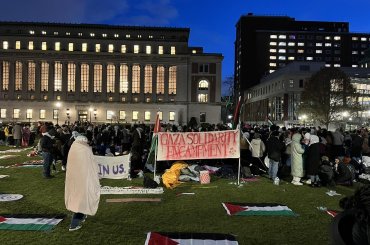I’m glad to see that Mondoweiss is posting relevant pieces of the Goldstone Report chunk-by-chunk — bite-sized morsels from the hundreds of pages of documents in the full report. But we didn’t need Goldstone to confirm that the Israel Defense Forces (IDF) strategy in Lebanon was a model for Gaza. That claim was made way back when the fighting was still going on — by a staunch friend and supporter of Israel, no less. But enough from me; res ipsa loquitur. I give you Tom Friedman of the New York Times as the Gaza War raged on January 13, 2009 (my emphasis):
Israel’s counterstrategy [in the summer of 2006] was to use its Air Force to pummel Hezbollah and, while not directly targeting the Lebanese civilians with whom Hezbollah was intertwined, to inflict substantial property damage and collateral casualties on Lebanon at large. It was not pretty, but it was logical. Israel basically said that when dealing with a nonstate actor, Hezbollah, nested among civilians, the only long-term source of deterrence was to exact enough pain on the civilians — the families and employers of the militants — to restrain Hezbollah in the future. […] That was the education of Hezbollah. Has Israel seen its last conflict with Hezbollah? I doubt it. But Hezbollah, which has done nothing for Hamas, will think three times next time. That is probably all Israel can achieve with a nonstate actor. In Gaza, I still can’t tell if Israel is trying to eradicate Hamas or trying to "educate" Hamas, by inflicting a heavy death toll on Hamas militants and heavy pain on the Gaza population. If it is out to destroy Hamas, casualties will be horrific and the aftermath could be Somalia-like chaos. If it is out to educate Hamas, Israel may have achieved its aims.
At the time, Friedman was undecided. But a year later it’s clear which of his options the IDF went for: To "educate" Hamas, as Friedman grotesquely characterized an assault that saw the destruction of universities and schools. With all the destruction and death of Friedman’s "education," it’s scary to even think about what an effort to "eradicate" Hamas might have looked like (as Friedman hints).
The column was problematic in so many ways, I don’t even know where to start. (Though the piece was a slight improvement over his nonsensical column of the week before, which was skewered brilliantly by Matt Taibbi.) First up was a glaring mistake where Friedman says the dovish Israeli approach of the late ’90s led to unilateral Israeli withdrawal from the West Bank and Gaza. Of course, both are very much under military occupation both outright and by siege, respectively. Another problem was the naivete of his prescription for healing the crisis:
Now [Israel’s] focus, and the Obama team’s focus, should be on creating a clear choice for Hamas for the world to see: Are you about destroying Israel or building Gaza?
It’s obvious now that Israel also had no intention of giving Hamas the opportunity of "building Gaza"; see the siege. But the most mind-numbing aspect of Friedman’s column was that he seemed to have bumbled his way into admitting that civilians were targets of the IDF operations in Lebanon and Gaza in an attempt to show them the price tag of supporting non-state resistance groups. Violence against civilians to effect political change is terrorism — and Friedman endorsed this "education" policy."It was not pretty, but it was logical," he wrote of Lebanon, The only one I saw who picked up on that irony was Fairness and Accuracy in Reporting (FAIR). The watchdog put out an Action Alert a day after the op-ed ran, trotting out a similarly callous Friedman quote from 1999:
The "logical" plan, as Friedman explained it, is to punish civilians in the hopes that this will force the political change you prefer. This is precisely the "logic" of terrorists. […] This pro-terrorism argument has been made before by Friedman, who advocated the same sort of terror against Serbs, writing (4/6/99) that "people tend to change their minds and adjust their goals as they see the price they are paying mount. Twelve days of surgical bombing was never going to turn Serbia around. Let’s see what 12 weeks of less than surgical bombing does. Give war a chance."
It’s a quote he uses again and again — "Give war a chance." And it keeps winning him Pulitzers and other accolades like being named overwhelmingly Washington’s most influential columnist in a poll of "Congressional and political insiders" — representative of the "Beltway bubble." I’m not exactly sure why. I find his mind to be a literary black hole leading to dark and foreboding places, as Friedman himself might say. But since so many people buy into Friedman’s stuff, you’d think that when Goldstone makes the same claim — in less strident language — it might gain some traction. But the same Congress that picked Friedman overwhelming denounces Goldstone. Not to mention Israel’s response to the Goldstone Report.
This post originally appeared here at LobeLog. Ali Gharib is a New York-based journalist on U.S. foreign policy with a focus on the Middle East and Central Asia. His work has appeared at Inter Press Service, where he was the Deputy Washington Bureau Chief.

